6th page
Progressive Thinkers as of 12/1/2022
|
| ||||||||||||||||||||||||||||||||||||||||||||||||||||||||||||||||||||||||||||||||||||||||||||||||||||||||||||||||||||||||||||||||||||||||||||||||||||||
In this Language Narrative I have been exploring various paths towards an analysis of Language which has strayed far from the more normalized introductory courses one might run into involving a discussion of language, if only because my definition and tactic of pursuit must abide by the tools being employed, which is a preferred usage of the "threes"-phenomena. This usage is one in which the script "1- 2- Many" plays a roll along with the alternative references of "3 extremes" as well two extremes and a centrality, where in both cases looking too hard at such labels might incline one to be inflexible in how they are used. Since there is more philosophy used in a discussion of language, the language in which an attempted philosophy is applied needs to be addressed. For example, if we turn to the tools of logic titled inductive and deductive, are we speaking of extremes or some centrality? Or do we use a three-patterned syllogistic template of Major Premise- Minor Premise- Conclusion? The fact that we are using a pattern-of-two or pattern-of-three suggests there is some underlying counting going on that may have its roots in our physiology or deeper still in our biology such at the DNA code which involves 2 strands, a triplet code and the so-called 4-bases which I have routinely described as a three -to- one structure, all 3 of which may be described as a 3-patterned ensemble. Again and again in multiple instances we can see the presence of a 3-part theme where any one of a series articles of a given three pattern may be missing, mis-identified, or obscured, or not yet existing due to one or another reason such as age, context or application. In any and all cases involving an attempted usage of philosophy on the material of a subject, the language being applied may at times be the very stumbling block preventing us from locating the answer we seek. Very often the case is that we need the language of philosophy being used in a different subject than that which we are presently involved with.
One of the most major problems with philosophy is that it is routinely adopting the language garments of whatever subject it is being applied to. As noted in a previous page, there is the standard habit of identifying Philosophy according to the subject it is associated with, such as the philosophy of Mathematics, or the philosophy of language, or the philosophy of physics, etc... It is not permitted to have its own identity. However, it would be rather odd to find philosophy being mentioned in terms such as the "Philosophy of Philosophy". The same goes for the 3-patterned phrase of the "Science of Philosophy". For some reason, there is an inclination for people to flip-flop this statement around and contour it in a manner such as the "Philosophy of Science" when the three are appreciably different animals. The Philosophy of Philosophy, Philosophy of Science, and Science of Philosophy entail the usage of different languages in thinking about them. The problem is, most people are not cognitively multi-lingual in the respect necessary for seeing them as being different. Most people don't even know they exist, including professional philosophers. Instead of recognizing them as separate breeds, they are typically bunched together and described in a disparaging way as some humans or dogs are characterized. For example, we use the terms mutt, mongrel, mixed breed, coyote, half-breed, stray, wild, etc., all of which are different terms describing a generality of disparaging thought by the user. When an observer is not skilled in making a deduction, they resort to characterizations most familiar, that is if they even take this much time to think about them. Philosophy has not acquired the entitlement of the label "Science of Philosophy" because no one has taken Philosophy out of its adopted families of so very many different subjects, in order to let it prosper on its own... a sort of Pure Philosophy much like those who advocated the continuing need for a Pure Mathematics, or some other supposed expression of an Ultra consciousness.
Let me propose that we use the idea of a "1- 2- Many" formula as a beginning step in the direction for initiating the Scientification of Philosophy.
For those of you who may be familiar with the following orientation, which is an earlier version of the "1- 2- Many" (cognitive language script), I have an update.
Laozi (author of Tao Te China): Dao produces one. One produces two. Two produces three. Three produces the ten thousand things. (In classical Chinese, the "ten thousand things" means "everything." Commentators have long disagreed over what the "one, two, and three" refers to, usually plugging in their favorite cosmological, cosmogonic, or metaphysical model.) Laozi further writes: Something amorphous & consummate existed before Heaven & Earth. Solitude! Vast! Standing alone, unaltering. Going everywhere, yet unthreatened. It can be considered the Mother of the World. I don't know its name, so I designate it "Dao." Compelled to consider it, name it "Great." (Dao is considered indistinct & undefinable.)
Here is the update which I constructed this AM (31st Dec. 2022). The quantity of five represents itself as a third hand in humanity's attempt to grasp beyond itself:
|
Plants have successfully developed to the point of being able to use the "3" (triploidy), but the complexity of animal biology has not. There remain too many errors with current experiments being conducted by Nature. Triploidy often yields sterility, deformity or death. Yet Nature continues entering in the "threes" formula, but has not yet got the mixture of ingredients quite right in terms of environment, diet, cognitive realization of what's taking place, etc... Nature keeps trying but the place and hour have not been reached whereby the "3" can be used for reaching the "Many", the Multiplicity, the Plurality. Hence... for the time being, it retains a usage of the "2". However, if humanity is not prepared nor willing to make the transition, then it will provide the vehicle for diseases to develop.
Humans have carefully selected and cultivated plants for food, clothing, shelter, fibre, and beauty for thousands of years. Disease is just one of many hazards that must be considered when plants are taken out of their natural environment and grown in pure stands under what are often abnormal conditions. Many valuable crop and ornamental plants are very susceptible to disease and would have difficulty surviving in nature without human intervention. Cultivated plants are often more susceptible to disease than are their wild relatives. This is because large numbers of the same species or variety, having a uniform genetic background, are grown close together, sometimes over many thousands of square kilometres. A pathogen may spread rapidly under these conditions.
In general, a plant becomes diseased when it is continuously disturbed by some causal agent that results in an abnormal physiological process that disrupts the plant's normal structure, growth, function, or other activities. This interference with one or more of a plant's essential physiological or biochemical systems elicits characteristic pathological conditions or symptoms. (A broad classification of disease can be termed classified according to the nature of their primary causal agent, either infectious or noninfectious.)
Disease development and transmission (Pathogenesis and saprogenesis):
Pathogenesis is the stage of disease in which the pathogen is in intimate association with living host tissue. Three fairly distinct stages are involved:
- Inoculation: transfer of the pathogen to the infection court, or area in which invasion of the plant occurs (the infection court may be the unbroken plant surface, a variety of wounds, or natural openings—e.g., stomates [microscopic pores in leaf surfaces], hydathodes [stomatelike openings that secrete water], or lenticels [small openings in tree bark])
- Incubation: the period of time between the arrival of the pathogen in the infection court and the appearance of symptoms
- Infection: the appearance of disease symptoms accompanied by the establishment and spread of the pathogen.
Requirements for disease development:
Infectious disease cannot develop if any one of the following three basic conditions is lacking:>/p>
- The proper environment, the most important environmental factors being the amount and frequency of rains or heavy dews, the relative humidity, and the air and soil temperatures.
- The presence of a virulent pathogen.
- A susceptible host.
Effective disease-control measures are aimed at breaking this environment-pathogen-host triangle.
Obtaining disease-resistant plants:
Several means of obtaining disease-resistant plants are commonly employed alone or in combination. These include:
- Introduction from an outside source.
- Selection.
- Induced variation.
All three may be used at different stages in a continuous process; for example:
- Varieties free from injurious insects or plant diseases may be introduced for comparison with local varieties.
- The more promising lines or strains are then selected for further propagation, and they are further improved by promoting as much variation as possible through hybridization or special treatment.
- Selection of the plants showing greatest promise takes place.
"plant disease." Encyclopædia Britannica, 2013.
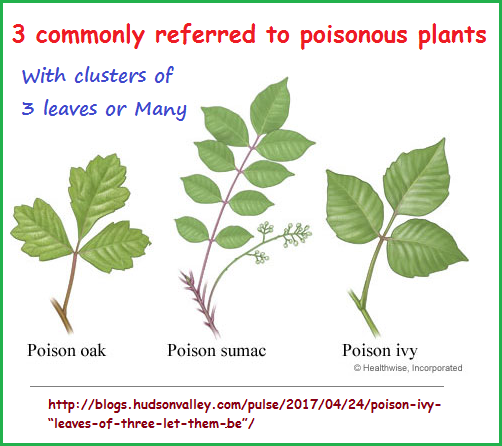
3 poisons of Biological origin, (Biotoxins can be conveniently grouped into three major categories:)
- Microbial toxins, poisons produced by bacteria, blue-green algae, dinoflagellates, golden-brown algae, etc.,
- Phytotoxins, poisons produced by plants.
- Sootoxins, poisons produced by animals.
("poison." Encyclopædia Britannica, 2013.)
Intrauterine human development has three stages:
- Implantation.
- Post-implantation.
- Fetal development.
The first two stages are the embryonic stages and last through the first eight weeks after conception. The fetal stage begins in the ninth week and continues to birth.
Depending on the developmental stage, chemical exposure in the mother can result in different degrees of toxicity in the embryo or fetus. In the pre-implantation period, a toxic chemical can kill some of the cells in the blastocyst, resulting in the death of the embryo. During the post-implantation period, chemical-induced cell death leads to one of two outcomes. If death is confined to those cells undergoing active cell division at the moment, the corresponding organs are affected, resulting in malformation. If the cell death is generalized without significant replication by the remaining cells to sustain life, the embryo dies. During the third, fetal, period, chemical injury can retard growth or, if severe enough, kill the fetus. ()
In regard to poisoning, chemicals can be divided into three broad groups:
- Agricultural and industrial chemicals. (The majority of agricultural chemicals are pesticides, which include insecticides, herbicides, fungicides, fumigants, and rodenticides.)
- Drugs and health care products. (The term industrial chemicals is used to refer to chemicals used neither in agriculture nor as drugs. Therefore, it includes chemicals used in industry, as well as chemicals found in or near households. Poisoning with industrial chemicals occurs most often by either percutaneous or inhalation routes.)
- Biological poisons—i.e., plant and animal sources. (Biotoxins can be conveniently grouped into three major categories: See listing above.)
- A polypeptide is a string of three or more amino acids. A few polypeptides and amines are toxic to animals.
Poisonous animals may be classified according to whether they are eaten, inject a venom, or are touched. "poison." Encyclopædia Britannica,2013.)
Let us make note of the "3" as an ideological perspective of poisoning:
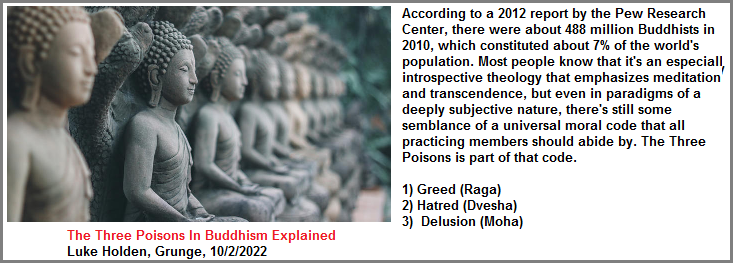
"Leaves of three, let them be" is an adage that has been used to describe certain poisonous plants such as the (poison) sumac, (poison) ivy, and (poison) o ak.
Another avenue of poisoning is that of radiation:
From the beginning, life has evolved in the presence of natural background ionizing radiation. The (3) principal types and sources of such radiation are:
- Cosmic rays, which impinge on the Earth from outer space.
- Terrestrial radiations, which are released by the disintegration of radium, thorium, uranium, and other radioactive minerals in the Earth's crust.
- Internal radiations, which are emitted by the disintegration of potassium-40, carbon-14, and other radioactive isotopes that are normally present within living cells.
The average total dose received from all three sources by a person residing at sea level is approximately 0.91 mSv per year; however, a dose twice this size may be received by a person residing at a higher elevation such as Denver, Colo., where cosmic rays are more intense, or by a person residing in a geographic region where the radium content of the soil is relatively high. In the latter type of region, the radioactive gas radon, which is formed in the decay of radium, may enter a dwelling through its floor or basement walls and accumulate in the indoor air unless the dwelling is well ventilated periodically; occupants of such a dwelling may therefore receive a dose as high as 100 mSv per year in their lungs from inhalation of the entrapped radon and its disintegration products.
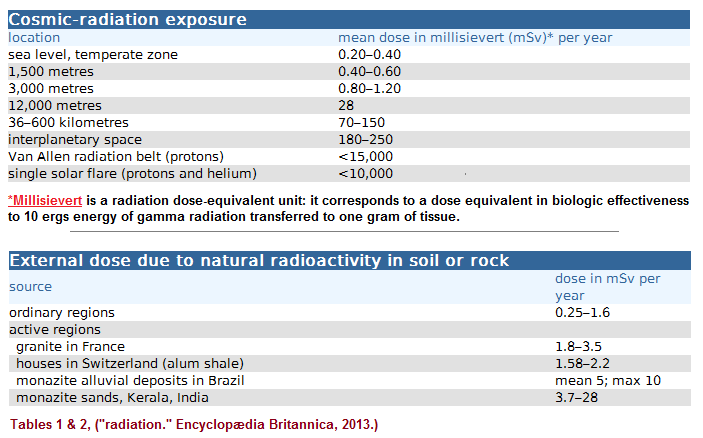
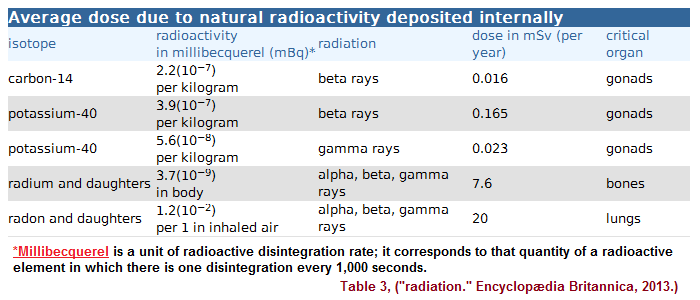
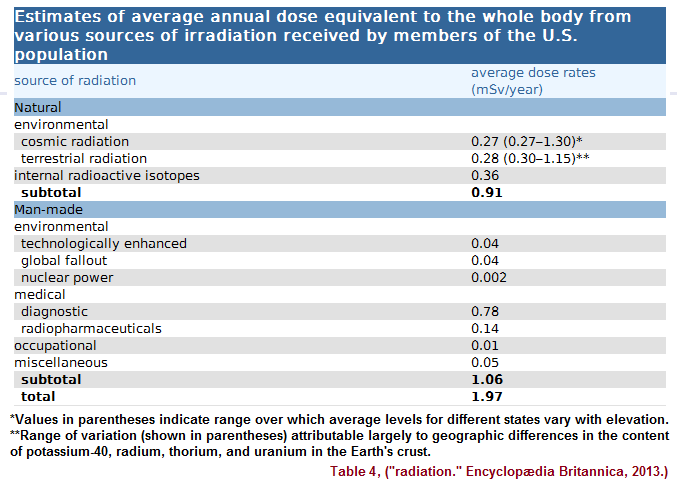
There are several instances in which the presence of "3" items, ideas, articles, etc., represent something that is undesirable. However, there are several instances in which the presence of "3" represents something desirable. And introduction into the field of particle physics of which I will only explore briefly since there are very many topics related to language that I must address, can begun by continuing with the focus on radiation by illustration three types of radiation in similar ways:
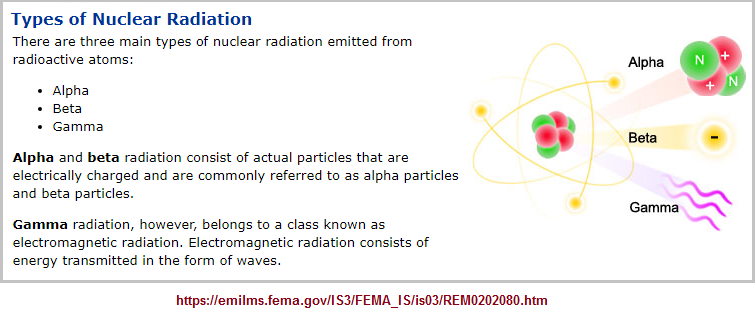
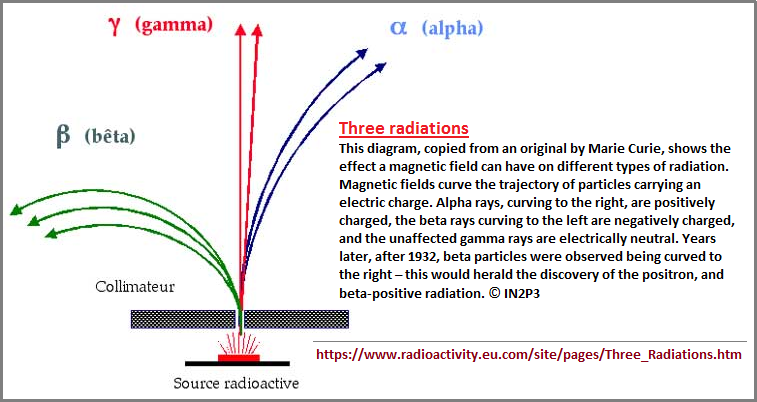
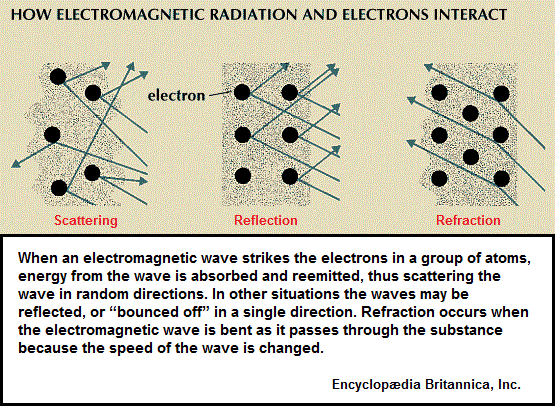
Getting the public cognitively prepared for the eventuality that Nature (as a chemist, mathematician, biologist, physicist, philosopher, tinkerer, historian, etc...) will eventually get the ingredients in the correct proportion out of which a new species of humanity is to come forth, is that which the whole of society must prepare for. Preparation for such an arrival (much like a newborn) will allow for the transition in life's totality of changes to go more smoothly, by preventing institutions from being not only obstacles, but an unneeded nemesis... resulting in embattlements involving some financial concern, when it is the fortune of the entire human race which is being placed on the 3 scales of a justice where the present day philosophies and beliefs reduce to a dichotomy so as to control the end result in their favor. Such institutions as the currency of Western Religions and Eastern philosophies are, can be immensely helpful and realize their time is short, that their shelf-life of having assisted humanity is coming to an end and must themselves realize that as an embodiment of a truth, their very soul is being called upon to leave humanity in the care of a younger generation whose contemplations pay their due respects to the old nursemaids, but come to accept that their age is not ageless, and they neither have the strength nor energy to keep up with the youthfulness of humanity about to begin. And yet those of the New Age in its dawning must be fully prepared to be met with those institutions, those individuals who will play the part of a protagonist who will use all their resources, all their connections, all their nefarious wiles and whims to promote an antagonism and be a hindrance because they cling on to the remnants of a false Salvation, of a false Ascension and a false Enlightenment. These three articles if acting as protagonists instead of proponents...as currently used... are poisons to the Heart, Mind and Soul of that in the making.
Biology: Alternation of generations, also called Metagenesis, or Heterogenesisa:
The alternation of a sexual phase and an asexual phase in the life cycle of an organism. The two phases, or generations, are often morphologically, and sometimes chromosomally, distinct.
In algae, fungi, mosses, ferns, and seed plants, alternation of generations is common; it is not always easy to observe, however, since one or the other of the generations is often very small, even microscopic. The sexual phase, called the gametophyte, produces gametes, or sex cells; the asexual phase, or sporophyte, produces spores asexually. In terms of chromosomes, the gametophyte has a single (i.e., monoploid, or haploid) set, and the sporophyte has a double (diploid) set.
Among animals, many invertebrates have an alternation of sexual and asexual generations (e.g., protozoans, jellyfish, flatworms), but the alternation of haploid and diploid generations is unknown. ("alternation of generations." Encyclopædia Britannica, 2013.)
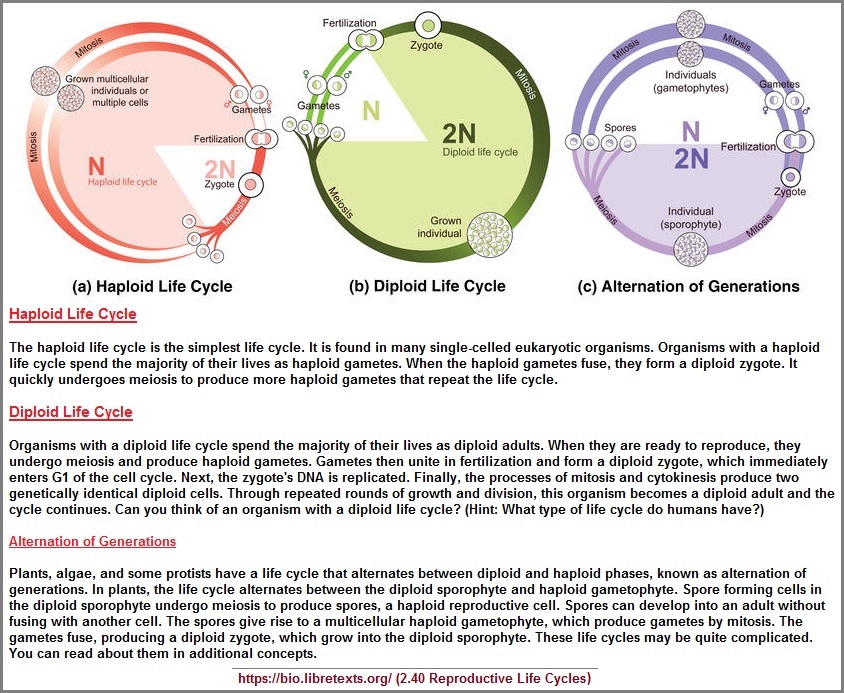
See also: Biological Life Cycle
X-Trisomy: sex chromosome disorder of human females, in which three X chromosomes are present, rather than the normal pair. More common than Turner's syndrome, where only one X chromosome is present, X-trisomy usually remains undetected because affected individuals appear normal, experience puberty, and are usually fertile. Statistical studies suggest a slightly increased frequency of mental disturbance, retardation, or both. ("X-trisomy." Encyclopædia Britannica, 2013.)
XYY-Trisomy: relatively common human sex chromosome anomaly in which a male has two Y chromosomes rather than one. It occurs in 1 in 500–1,000 live male births, and individuals with the anomaly are often characterized by tallness and severe acne and sometimes by skeletal malformations and mental deficiency. It has been suggested that the presence of an extra Y chromosome in an individual may cause him to be more aggressive and prone to criminal behaviour, a condition called the "supermale" syndrome. Studies of prison populations have tended to confirm this hypothesis; but subsequent studies of the general population, especially those in which affected individuals were observed from early childhood over a long period of time, have cast serious doubt on the validity of linking the chromosomal anomaly directly to behavioral abnormalities. ("XYY-trisomy." Encyclopædia Britannica 2013.)
Aneuploids
:Some cells have an abnormal number of chromosomes that is not a whole multiple of the haploid number. This condition is called aneuploidy. Most aneuploids arise by nondisjunction, a failure of homologous chromosomes to separate at meiosis. When a gamete of this type is fertilized by a normal gamete, the zygotes formed will have an unequal distribution of chromosomes. Such genomic imbalance results in severe abnormalities or death. Only aneuploids involving small chromosomes tend to survive and even then only with an aberrant phenotype.
The most common form of aneuploidy in humans results in Down syndrome, a suite of specific disorders in individuals possessing an extra chromosome 21 (trisomy 21). The symptoms of Down syndrome include mental retardation, severe disorders of internal organs such as the heart and kidneys, up-slanted eyes, an enlarged tongue, and abnormal dermal ridge patterns on the fingers, palms, and soles. Other forms of aneuploidy in humans result from abnormal numbers of sex chromosomes. Turner syndrome is a condition in which females have only one X chromosome. Symptoms may include short stature, webbed neck, kidney or heart malformations, underdeveloped sex characteristics, or sterility. Klinefelter syndrome is a condition in which males have one extra female sex chromosome, resulting in an XXY pattern. (Other, less frequent, chromosomal patterns include XXXY, XXXXY, XXYY, and XXXYY.) Symptoms of Klinefelter syndrome may include sterility, a tall physique, lack of secondary sex characteristics, breast development, and learning disabilities. (Encyclopædia Britannica, 2013.)
When speaking of breeding, there are three sorts of breeding: (Farm Animal Breeding and Reproduction:)
- Cross-breeding: individuals of different breeds or lines are used to mate.
- Pure breeding: the same breed or lines are used to mate.
- Inbreeding: two close relatives mate. The closer the relation, the higher the inbreeding.
When looking at the terms used in biology involving chromosomal differences with respect to breeding, one necessarily comes across monoploid, monosomy, haploid, diploid, mosaicism, polyploidy, tetrapolidy, pentaploidy, etc... Just remember we are using a "1- 2- Many tool" in our model of philosophical dissection when trying to line them up in a basic type of sorting-out for cross-subject referencing and parallelism. If it's three or more one can safely characterize it as a "Many".
Ploidy is the number of complete sets of chromosomes in a cell, and hence the number of possible alleles for autosomal and pseudoautosomal genes. Sets of chromosomes refer to the number of maternal and paternal chromosome copies, respectively, in each homologous chromosome pair, which chromosomes naturally exist as. Somatic cells, tissues, and individual organisms can be described according to the number of sets of chromosomes present (the "ploidy level"): monoploid (1 set), diploid (2 sets), triploid (3 sets), tetraploid (4 sets), pentaploid (5 sets), hexaploid (6 sets), heptaploid or septaploid (7 sets), etc. The generic term polyploid is often used to describe cells with three or more chromosome sets.
Polyploidy occurs commonly in plants, but rarely in animals. Even in diploid organisms, many somatic cells are polyploid due to a process called endoreduplication, where duplication of the genome occurs without mitosis (cell division). The extreme in polyploidy occurs in the fern genus Ophioglossum, the adder's-tongues, in which polyploidy results in chromosome counts in the hundreds, or, in at least one case, well over one thousand.
It is possible for polyploid organisms to revert to lower ploidy by haploidisation. ()
Date of (series) Origination: Saturday, 14th March 2020... 6:11 AM
Date of Initial Posting (this page): 31st December 2022... 2:20 PM, AST (Arizona Standard Time); Marana, AZ.